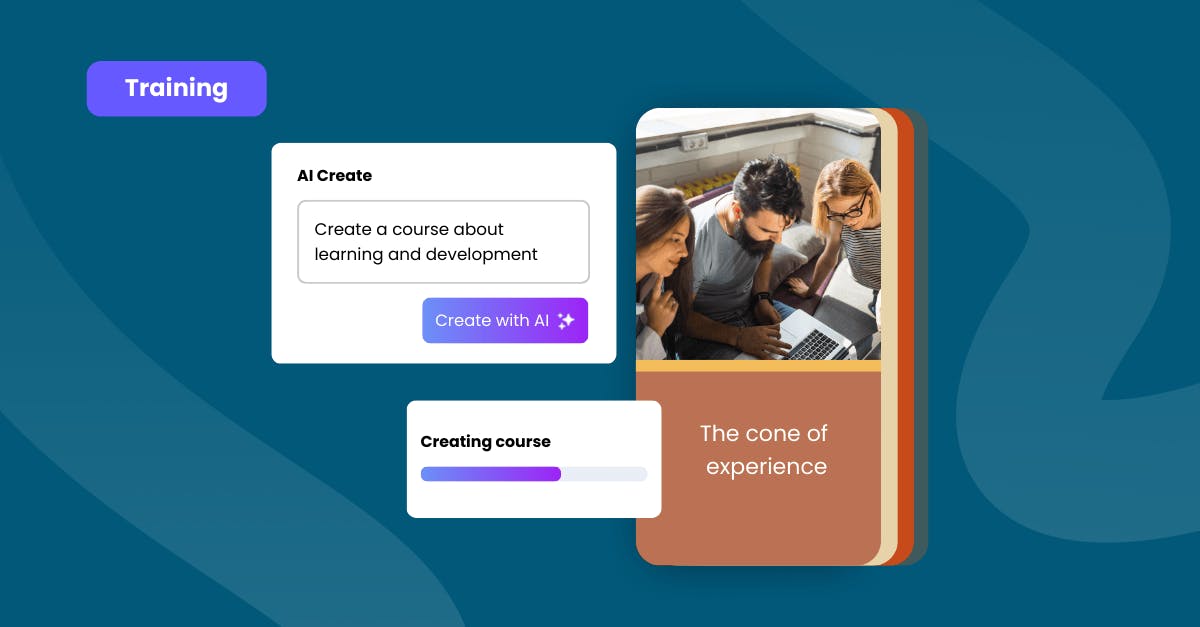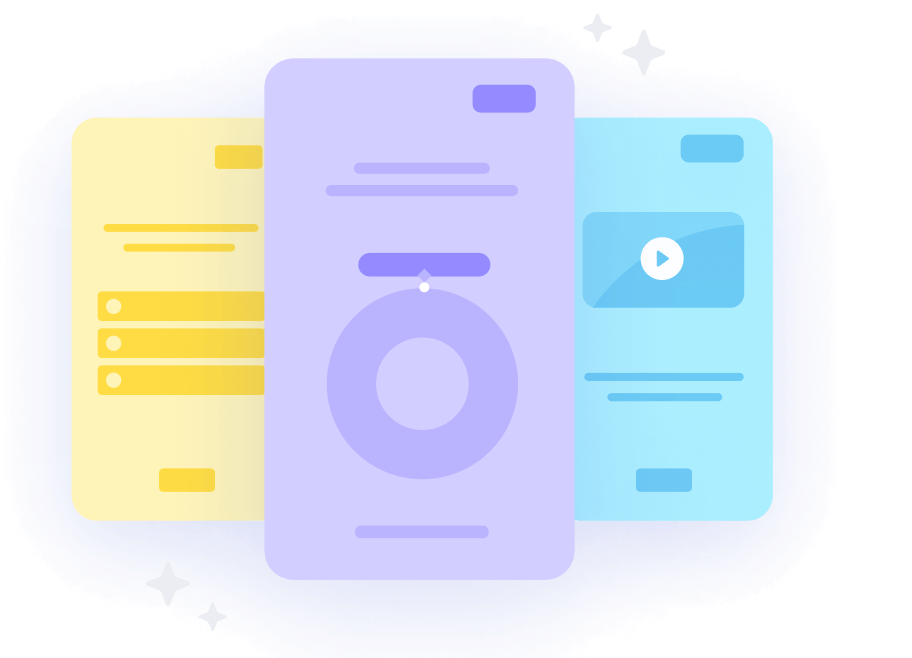A learning guide to Edgar Dale's cone of learning

Dale’s Cone of Experience can be used as a valuable model for creating rich learning experiences. But, there are a lot of misconceptions about it. So, we’re here to help you understand this theory and how to properly apply it in learning and development.
What is the Cone of Experience?
The cone of experience is a learning model introduced by Edgar Dale that illustrates the concreteness levels of learning experiences based on the medium. It takes the shape of an inverted cone, which shows the abstract learning experience at the peak and progresses into the most concrete experiences down to the base.
Dale emphasizes that the Cone is merely a visual analogy of the progression of abstract learning experiences to concrete ones. Similarly, it represents that the more concrete the learning experiences are, the more senses are involved–seeing, hearing, tasting, touching, and feeling.
In this article, we'll explore the concrete learner's definition and other important key elements of the cone of experience.
Create rich and interactive learning experiences with SC Training (formerly EdApp). Join SC Training today!
What are the levels of the Cone of Experience?
The Cone of Experience originally has 11 levels, but more modern interpretations of the model only include 10 levels. The top levels include learning mediums that give learners abstract learning experiences.
The middle levels can be abstract or concrete, depending on whether there’s an opportunity for the learner to directly participate in the experience or not. The base then shows the learning mediums where learners can have concrete learning experiences. Now, let’s explore each level.
1. Verbal symbols
Verbal symbols refer to texts or words, like terminologies, rules, formulas, and other similar concepts. It’s located at the peak of the cone, which means that this is the most abstract learning experience as they don’t give any visual representation of a subject.
For instance, the word “cloud” is simply what is. The word itself doesn’t look like what it represents in any way. It’s a very intangible concept, so not many senses are involved.
2. Visual symbols
Visual symbols are graphic representations of concepts, which include charts, diagrams, infographics, graphs, flowcharts, and the like. They are used to help make concepts easier for our brains to understand and interpret concepts.
In practice, you can use arrows to visually show the flow of a step-by-step process. Or, you can use charts to interpret numerical data.
3. Recordings, radio, and still pictures
This level simply refers to photographs and audio recordings like podcasts. While this level is less abstract, learners are still merely observers. This level also debunks the misconception that auditory media is better than visual media since photos and audio are put together at the same level.
In training, you can use audio recordings to teach your staff how to pronounce certain words so they can properly greet different foreign customers.
4. Motion pictures and Educational television
Recent publications combine motion pictures and educational television on the same level as they are similar mediums. But, in the original model, they were counted as separate levels. These levels are all about learning videos and animations where both visual and auditory senses are being used.
While these mediums don’t create realistic experiences, they provide interesting customization options to create a deliberate learning experience. These manipulations include editing out irrelevant clips, zooming in on important details, etc. Similarly, learners have the option to rewind or replay videos as needed.
5. Exhibits
Exhibits are meaningful displays with limited handling. This means that sometimes exhibits can be restricted to observation only. Meanwhile, other kinds of exhibits are designed to be interactive, which encourages direct participation and the use of a range of senses from learners.
This makes it the first level in the Cone of Experience that moves away from abstractness, unlike the previous levels.
Galleries and museums are examples of exhibits, giving learners the opportunity to closely expose themselves to educational materials, inventions, and many more.
6. Study trips/Field trips
Study trips are where learners have the opportunity to observe different objects, situations, activities, and other related information in a real-world setting. It’s a level that gives learners a feast of real sights and sounds.
Much like exhibits, in sometimes instances, learners have the opportunity to briefly participate in a real-life experience of a job or activity. For example, on a trip to a fire station, your learners will participate in trying out how to put out a fire using a fire extinguisher.
7. Demonstrations
Demonstrations are visual explanations of how something works. It also works as a visual guide on how to do something. Typically, this medium of instruction is used when there are logistic limitations for a hands-on learning activity for everyone. In essence, learners learn from observing someone else do an activity.
8. Dramatized experiences
Dramatized experiences are recreated situations where learners can directly participate, such as role-plays, that are based on real-life happenings. Through this activity, learners can immerse themselves in a situation even if it’s not the real thing yet. This also gives them the opportunity to safely fail in a recreated experience.
For example, this type of learning experience can be applied in practicing how to assist a passenger on a plane. Since it’s only a role-play exercise, the participant can make a mistake and learn from it, so they can execute it properly in real life.
9. Contrived experiences
Contrived experiences are edited or imitated versions of reality, like mock-ups, simulations, gamification, and models. As some concepts are too complex, this kind of learning experience makes it easier to visualize and understand a subject.
In some cases, it also makes teaching a lot more flexible as these representative models can be easily manipulated or operated for educational purposes.
10. Direct purposeful experiences
Direct purposeful experiences simply refer to hands-on learning or practice of a real thing. It’s located at the base of the Cone of Experience, which means that it gives the most concrete, tangible learning experience.
That’s to say that at this level, learners are actively participating in an activity, allowing them to make use of all their senses in the learning process.
What is the purpose of the Cone of Experience?
The main purpose of the Cone of Experience is to help you identify and select the right audiovisual mediums and resources for your training initiatives. Dale illustrates that the progression from the base (concrete learning experiences) to the top (abstract learning experiences), showing the gradual decrease of sensory information.
What are some common misconceptions about Dale’s Cone of Experience?
The development of various misuses and misinterpretations has distorted Edgar Dale's Cone of Experience. Let's explore these common mistakes.
The cone concludes retention rates for each level
Many people misunderstand the cone as a hierarchy that indicates how much learners can remember at each level of experience. This corrupted version attaches a retention rate for every learning approach. It suggests that individuals remember more information from personal experiences than from ideas they consume.
Dale never included these statistics. The percentages came from unsupported assumptions about learning from the past that have been repeatedly echoed and wrongly associated with the cone of experience.
Using the cone as a basis for the most effective learning method
Similar to the previous misconception, the Cone of Experience is often viewed as a solution for identifying the best learning experiences. Dale’s distinction between concrete and abstract instructional concepts leads to the conclusion that sensory, tangible approaches are more effective for teaching.
This is simply untrue. Despite its shape, the cone is not meant to be a basis of what mediums are the least or most effective. Edgar Dale aimed to visualize the varying ways individuals can understand messages, not to create preferences.
The cone is a learning sequence
Many mistake Edgar’s cone as a step-by-step guide for effective learning. As a result, they believe that learning must begin with concrete, hands-on techniques and progress towards more abstract activities.
The model is meant to help instructional designers develop a balanced learning plan that effectively incorporates both tangible and intangible experiences. This way, they can create well-rounded learning programs that attack all angles of a concept. Remember, the
Cone of Experience is not meant to be a roadmap for a lesson
Applying the Cone of Experience in instructional design
In instructional design, the Cone of Experience can help you create rich learning experiences by using different training methods and making interactive training lessons. You can also use it as a guide when considering what learning resources to develop.
While all these may seem like an overwhelming responsibility, applying them can be convenient with the help of learning experience design tools. Here, you can use different learning strategies all on one platform.
SC Training, an adaptive learning platform, is a perfect example of this training solution. It has microlearning and gamification features that make lessons short, straightforward, and fun. Using its course creation tool which includes many interactive templates, you can combine many learning experiences from the Cone, such as verbal symbols, visual symbols, recordings, videos, and so much more.
What’s more, is that you’re not limited to creating online learning experiences here. With its Practical Assessments feature, you can easily manage hands-on learning experiences through in-person training. And, no need for paper checklists. This tool allows you to evaluate their performance using a mobile device.
Try SC Training and transform your team's learning experiences!
Join our blog newsletter
Author
Shera Bariuad
Shera is a workplace learning expert with a background in planning performance-driven solutions for various business industries. She’s dedicated to driving better learning and development outcomes by providing training strategies for training managers and curating lists of tools and courses for learners. Outside of work, she spends her time reading, illustrating, and designing.
